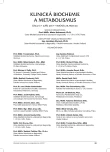Congenital disorders of glycosylation: alpha-dystroglycanopathies
Authors:
L. Zdražilová; N. Ondrušková; T. Honzík; H. Hansíková
Authors‘ workplace:
Laboratoř pro studium mitochondriálních poruch, Klinika dětského a dorostového lékařství, 1. lékařská
; fakulta Univerzity Karlovy a Všeobecná fakultní nemocnice v Praze, Ke Karlovu 2, Praha 2, 128
Česká republika
08
Published in:
Klin. Biochem. Metab., 25, 2017, No. 3, p. 96-100
Overview
Alpha-dystroglycanopathies are rare inherited diseases that belong to the group of congenital disorders of glycosylation, and due to their clinical symptoms they also fall into the category of hereditary muscular dystrophies. They are caused by deficient glycosylation of alpha-dystroglycan’s mucin domain, resulting in reduced affinity of this protein to the laminin G-domain of extracellular matrix ligands. Alpha-dystroglycan is most represented in muscles, but it is also expressed in nerve cells, eyes, epithelium and other organs and tissues. The most common forms of alpha-dystroglycanopathies manifest with muscular dystrophy, ocular malformations and defects of central nervous system. To this date, mutations in about 20 different genes have been described to cause alpha-dystroglycanopaties.
Keywords:
alpha-dystroglycan, alpha-dystroglycanopathy, congenital disorders of glycosylation.
Sources
1. Freeze, H. H., Chong, J. X., Bamshad, M. J., Ng, B.G. Solving glycosylation disorders: Fundamental approaches reveal complicated pathways. Am. J Hum. Genet., 2014, 94 (2), p. 161-175
2. Ibraghimov-Beskrovnaya, O., Milatovich, A., Ozcelik T. et al. Human dystroglycan: skeletal muscle cDNA, genomic structure, origin of tissue specific isoforms and chromosomal localization. Hum. Mol. genet., 1993, 2 (10), p. 1651-1657.
3. Ibraghimov-Besrovnaya, O.,Ervasti, J. M., Leveille, C. J., Slaughter, C. A., Sernett, S. W., Campbell, K. P. Primary structure of dystrophin-associated glycoproteins linking dystrophin to the extracellular matrix. Nature.,1992, 355, p. 696-702.
4. Brancaccio, A., Schulthess, T., Gesemann, M., Engel, J. Electron microscopic evidence for a mucin-like region in chick muscle α-dystroglycan. FEBS lett., 1995, 368 (1), p. 139-142.
5. Ervasti, J. M., Campbell, K. P. Membrane organization of the dystrophin-glycoprotein complex. Cell., 1991, 66 (6), p. 1121-1131.
6. Blake, D. J., Weir, A., Newey, S. E., Davies, K. E. Function and genetics of dystrophin and dystrophin-related proteins in muscle. Physiol. Rev., 2002, 82 (2), p. 291-329.
7. Bowe, M. A., Deyst, K. A., Leszyk, J. D., Fallon, J. R. Identification and purification of an agrin receptor from Torpedo postsynaptic membranes: a heteromeric complex related to the dystroglycans. Neuron, 1994, 12 (5), p. 1173-1180.
8. Saito, F., Moore, S. A., Barresi, R. et al. Unique role of dystroglycan in peripheral nerve myelination, nodal structure, and sodium channel stabilization. Neuron, 2003, 38 (5), p. 747-758.
9. Winder, S. J. The complexities of dystroglycan. Trends Biochem. Sci., 2001, 26 (2), p. 118-124.
10. UniProt [Online], [Citace: 21. 2 2016.], Dostupný na www: <http://www.uniprot.org/uniprot/Q14118>
11. Chiba, A. K., Matsumura, H., Yamada, T. et al. Structures of sialylated O-linked oligosaccharides of bovine peripheral nerve α-dystroglycan. The role of a novel O-mannosyl-type oligosaccharide in binding of α-dystroglycan with laminin. J Biol. Chem., 1997, 272 (4), p. 2156-2162.
12. Willer, T., Valero, M. C., Tanner, W., Cruces, J., Strahl, S. O-mannosyl glycans: from yeast to novel associations with human disease. Curr. Opin. Struct. Biol., 2003, 13 (5), p. 621-630.
13. Live, D., Wells, L., Boons, G. J. Dissecting the Molecular Basis of the Role of the O-Mannosylation Pathway in Disease: α-Dystroglycan and Forms of Muscular Dystrophy. Chembiochem, 2013, 14 (18), p. 2392–2402.
14. Kanagawa, M., Kobayashi, K., Tajiri, M. et al. Identification of a Post-translational Modification with Ribitol-Phosphate and Its Defect in Muscular Dystrophy, Cell Rep., 2016, 14 (9), p. 2209-2223.
15. Stevens, E., Torelli, S., Feng, L. et al. Flow cytometry for the analysis of α-dystroglycan glycosylation in fibroblasts from patients with dystroglycanopathies. PLoS ONE., 2013, 8 (7), e68958
16. Hewitt, J.E. Abnormal glycosylation of dystroglycan in human genetic disease. Biochim. Biophys. Acta., 2009, 1792 (9), p. 853-861.
17. Geis, T., Marquard, K., Rodl, T. et al. Homozygous dystroglycan mutation associated with a novel muscle-eye-brain disease-like phenotype with multicystic leucodystrophy. Neurogenetics, 2013,14 (3), p. 205-213.
18. Wells, L. The O-mannosylation pathway: glycosyltransferases and proteins implicated in congenital muscular dystrophy. J Biol. Chem., 2013, 288 (10), p. 6930-6935.
19. Riemersma, M., Froese, D. S., van Tol W. et al. Human ISPD Is a Cytidyltransferase Required for Dystroglycan O-Mannosylation. Chem. Biol., 2015, 22 (12), p. 1643-1652
20. Zdražilová, L. Dědičné poruchy glykosylace: alfa-dystroglykanopatie., Univerzita Karlova v Praze, 2016, Bakalářská práce.
21. Wang, C. H., Bonnemann, C. G., Rutkowski, A. et al. Consensus statement on standard of care for congenital muscular muscular dystrophies. J Child. Neurol., 2010, 25 (12), p. 1559-1581.
22. Mahmood O. A., Jiang X, Zhang Q. Limb-girdle muscular dystrophy subtypes: First-reported cohort from northeastern China. Neural Regen. Res., 2013, 8 (20), p. 1907-1918.
Labels
Clinical biochemistry Nuclear medicine Nutritive therapistArticle was published in
Clinical Biochemistry and Metabolism

2017 Issue 3
Most read in this issue
- „Normal“ laboratory finding
- Therapeutic monoclonal antibodies in clinical laboratory
- Congenital disorders of glycosylation: alpha-dystroglycanopathies
- Comparison of Measurement Free Light Chains by SPAPLUS and Immage 80
